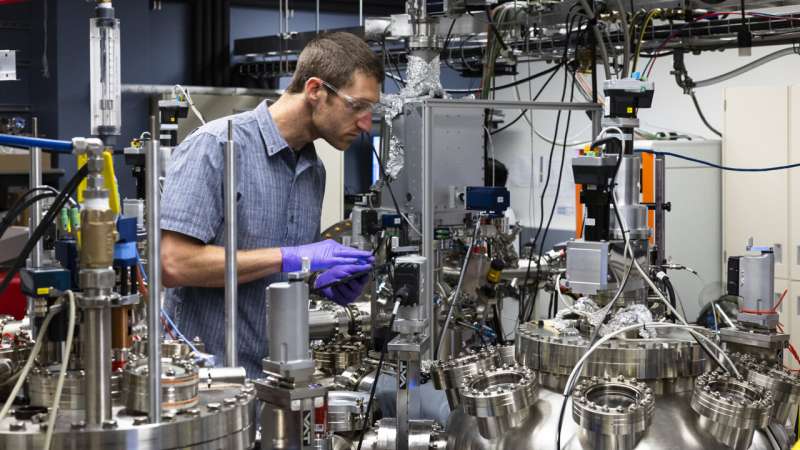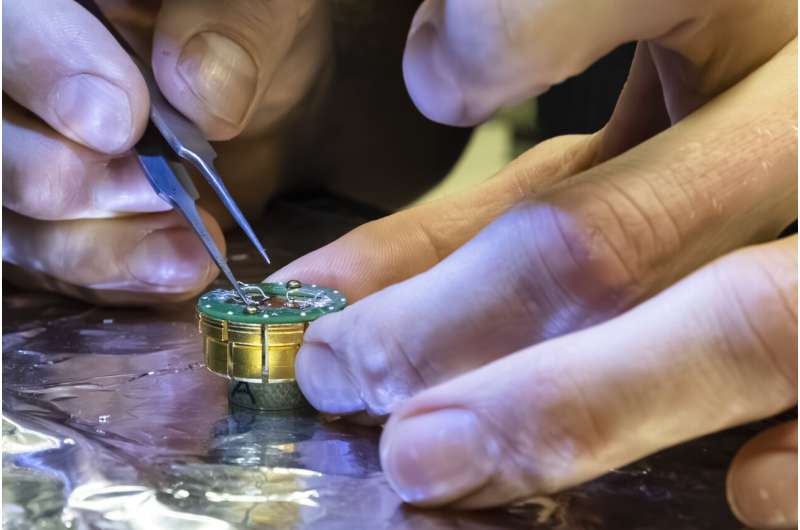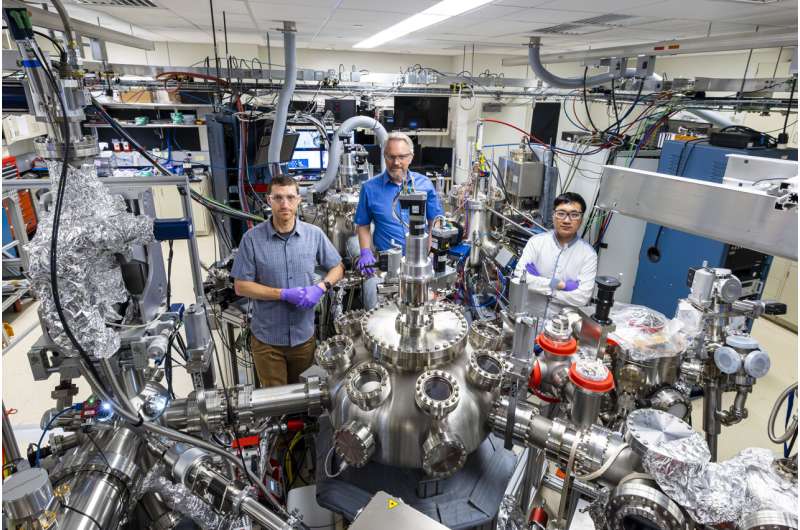Quantum computers process information using quantum bits, or qubits, based on fragile, short-lived quantum mechanical states. To make qubits robust and tailor them for applications, researchers from the Department of Energy’s Oak Ridge National Laboratory sought to create a new material system.
“We are pursuing a new route to create quantum computers using novel materials,” said ORNL materials scientist Robert Moore, who co-led a study published in Advanced Materials with ORNL colleague Matthew Brahlek, who is also a materials scientist.
They coupled a superconductor, which offers no resistance to electrical current, with a topological insulator, which has electrically conductive surfaces but an insulating interior. The result is an atomically sharp interface between crystalline thin films with different symmetric arrangements of atoms. The novel interface that they designed and engineered may give rise to exotic physics and host a unique quantum building block with potential as a superior qubit.
“The idea is to make qubits with materials that have more robust quantum mechanical properties,” Moore said. “What is important is that we have learned how to control the electronic structure of the topological insulator and the superconductor independently, so that we can tailor the electronic structure at that interface. This had never been done.”
Controlling the electronic structure on both sides of an interface may create something called Majorana particles inside the material. “In nature, we have particles and antiparticles, for example electrons and positrons, which annihilate each other when they come in contact. A Majorana particle is its own antiparticle,” Moore said. In 1937 Ettore Majorana predicted the existence of these exotic particles, whose existence remains to be proven.
In 2008, theorical physicists Liang Fu and Charlie Kane of the University of Pennsylvania proposed that creating a novel interface between a topological insulator with a superconductor would generate topological superconductivity, a new phase of matter predicted to host Majorana particles.

“If you have a pair of Majorana particles and move them around each other, there is a memory of this motion. They always know each other’s location,” Moore said. “This process could be used to encode quantum information and compute in new ways.”
However, realization of a new phase of matter that can host Majorana particles depends on finding the right material. Such an achievement takes a diverse team of experts.
When Moore came to ORNL in 2019, he brought a new expertise in angle-resolved photoemission spectroscopy, or ARPES, a technique for probing the electronic structure of materials. ARPES is based on the photoelectric effect, for which Albert Einstein was awarded the 1921 Nobel Prize in physics. It focuses a light source on a sample and characterizes electrons ejected from the material surface when the electrons absorb energy from the photons. The technique helps scientists understand how electrons behave inside a material.
This strategic investment in ARPES expertise helped ORNL win its bid to lead one of five DOE National Quantum Information Science Research Centers, the Quantum Science Center, which launched in 2020. Led by ORNL’s Travis Humble, the QSC aims to realize quantum computing and sensing applications by developing hardware and algorithms and discovering novel materials. Moore and his colleagues focus on topological materials for hardware development. Since April, Moore has also co-directed ORNL’s Interconnected Science Ecosystem, or INTERSECT, with Ben Mintz to develop laboratories of the future—smart, autonomously controlled processes and experiments with the potential to revolutionize research outcomes.
Brahlek, who joined ORNL in 2018 and recently received a DOE Early Career Research award, is an expert in precision synthesis of materials. To make superclean interfaces between a superconductor and topological insulator, he used molecular beam epitaxy, a method industry uses for large-scale fabrication of semiconductors for electronic devices.
With help from former postdoctoral fellow Tyler Smith, Brahlek performed the synthesis under ultrahigh vacuum. “Inside the chamber, there are fewer molecules bouncing around than in outer space. It is a really clean environment. It must be well controlled,” Brahlek said. “You start with little furnaces, each containing one element. Each furnace heats until the element inside starts to sublimate, or pass from solid to vapor state. This creates beams of elements. They all converge on a crystal substrate and adhere.”

He co-deposited iron, selenium and tellurium to make a superconductor that was one atomic layer thick. “If you can get the conditions exactly right, the deposited atoms will chemically bond and assemble, atomic layer by atomic layer, into a crystalline thin film,” Brahlek said.
“A key to getting the results was understanding how to combine bismuth telluride with iron selenide telluride at an atomic interface to gain the desired electronic behavior,” Brahlek said.
That accomplishment was tricky because the superconductor’s lattice of iron, selenium and tellurium comprises ordered square cells, whereas the topological insulator is a network of adjoining triangles. “We’re putting something square on something triangular, but surprisingly, the crystalline film grows nicely,” Brahlek said. “This accomplishment requires understanding the physics and chemistry that happen at these interfaces, which is critical to combining topological and superconducting properties in a single platform.”
That platform is the topological superconductor. To understand its topological properties, Moore used spin-resolved ARPES, with help from ORNL postdoctoral fellow Qiangsheng Lu, to probe quantum spin-dependent electronic structure at the interface of the topological insulator and the superconductor. Meanwhile, to confirm its superconducting behavior, Brahlek and former ORNL postdoctoral fellows Yun-Yi Pai and Michael Chilcote assisted with measurements of electrical resistance.
“We were able to see how the different electronic structures were interacting at the interface, and we were able to control those interactions to ensure all the ingredients for topological superconductivity exist,” Moore said. “We found that the desired topological properties only exist for specific selenium doping ranges. This was a surprise that is crucial for making qubits.”
Meanwhile, Hoyeon Jeon and An-Ping Li at ORNL’s Center for Nanophase Materials Sciences used scanning tunneling microscopy to characterize disorder in the materials. ORNL staff scientists Hu Miao and Satoshi Okamoto provided experimental and theoretical guidance throughout the study.

Crucial challenges remain. “We need to improve and better understand the materials at the atomic level, which is critical to confirming and using Majorana particles for applications,” Moore said. “The next step will be exploring possible Majorana particles using a newly installed ultralow-temperature scanning tunneling microscope instrument at CNMS.”
He added, “Achieving a qubit based on Majorana particles is one of the ultimate goals of the Quantum Science Center. The Majorana particle in materials is such an exotic state. Proving that it exists will require both building and testing a qubit-like device. It is an odd way to think about it, but you have to make a qubit to prove it is a qubit. We now know how to control the materials to the level required to make this happen.”
More information:
Robert G. Moore et al, Monolayer Superconductivity and Tunable Topological Electronic Structure at the Fe(Te,Se)/Bi2Te3 Interface, Advanced Materials (2023). DOI: 10.1002/adma.202210940
Citation:
Researchers advance topological superconductors for quantum computing (2023, September 20)
retrieved 20 September 2023
from
This document is subject to copyright. Apart from any fair dealing for the purpose of private study or research, no
part may be reproduced without the written permission. The content is provided for information purposes only.

